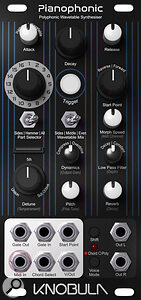Sometimes Knobula’s Pianophonic module sounds a whole lot like a piano, sometimes it just sounds piano‑ish, and sometimes it sounds nothing like a piano. Aside from anything else, it doesn’t exist only for acoustic piano sounds, which is one of the best things about it. Its basic architecture consists of three wavetabling oscillators and one sample playback engine. The three wavetables purport to emulate a piano’s three‑string hammer action — I suppose they do, without getting too forensic about phase coherence, but more pertinent about the oscillators is their positioning in the stereo field: one is placed on each side and one is in the middle. Atop these is a sampler engine, also panned centrally, which provides percussive transients; for conventional piano voices these are plinky ‘hammer’ sounds. For other sounds they’re, well, other sounds.
Concerning acoustic piano voices, the Pianophonic does a good job of sounding as realistic as possible with minimal elements. Obviously you won’t find the 4GB sample library of Toontrack’s EZkeys here, just a clever application of hybrid synthesis to essentially get the job done. Consequently its sonic character recalls those slightly hollow digital piano sounds of the 1980s and ’90s — something I happen to love. I should say that with this comes the occasional spate of audible artefacts, particularly when adjusting settings, but again I’ll chalk that up to the adorable digital character that the Pianophonic delivers so well.
The Pianophonic’s 16 factory presets range from acoustic pianos to a Yamaha DX‑series‑style piano sound and beyond: guitar, synth and even vocal sounds are here, each with their own ‘hammer’ sounds — that is, their own type of attack. The pluck of a guitar, for instance, or breath on the front of a vocal sound.
This is where things get a little more interesting: presets need not be loaded wholesale: it’s possible to load the ‘hammer’ sound and central wavetable from one preset and the panned wavetables from another. It’s also possible to load one’s own wavetables and samples into the Pianophonic via Knobula’s online Wave Slicer; a tool not yet available at the time of writing but one I’m very much looking forward to trying.
An ADR envelope furnishes the top of the Pianophonic’s panel. Turning the release time to full essentially switches in an endless drone, which is a nice touch. The attack stage is even less conventional: it’s more like a bipolar mixer between the hammer and wavetable sounds, so its default position is actually something like 10 o’clock. Any lower than this and you’ll just hear the hammer sound. Any higher and it’s wavetables only, which made for some truly beautiful string and reed organ‑type sounds straight out of the box.
The general envelope section is further endowed with a bipolar Start Point knob and a Morph Speed knob for tracking through the wavetable. The wavetable can be played forwards or backwards at a range of speeds, once again with the extreme end of the Morph Speed knob essentially freezing the waveform in place for simpler oscillator shapes. Lastly, at least in the first instance, a detune knob changes the pitch relationship between the three oscillators. This can move from subtle chorus to honky‑tonk detuned sounds, all the way to a fifth interval and then down to create a sub‑octave.
I’m happy to say that contrary to my expectation the reverb sounds gorgeous, feeding back beautifully at high settings.
The Pianophonic could reasonably be left there, but Knobula aren’t finished: ambitiously included is a bipolar DJ‑style low‑pass/high‑pass filter, a bipolar compressor‑distortion and even a 24‑bit stereo reverb. I’m happy to say that contrary to my expectation the reverb sounds gorgeous, feeding back beautifully at high settings. It’s placed after the filter circuit too, so it’s possible to sweep sounds up and down and hear them decay into space.
Truth be told, I would love to have seen a CV input for the filter, if nothing else for this very purpose. I actually would like to have seen a couple more CV inputs in general — at times I even wondered why this self‑sufficient MIDI‑controlled synth is in Eurorack format at all; it doesn’t exactly beg to integrate with the rest of a system and is certainly more at home with MIDI than it is CV, not least because it supports CC messages for many parameters I would like to have seen CV inputs for.
I also can’t help but think an extra few HP could have made space for more patch points and more control. In some ways, the Pianophonic is so detailed and capable that it almost feels like an undersell to jam it all onto a 12HP panel, but I’d be lying if I said I wasn’t feeling smug at the prospect of nestling a fully‑fledged synthesizer into my system like some kind of secret weapon. I’m genuinely not sure Knobula could have squeezed anything more in here, and for that they should be commended.
We seek in Eurorack, do we not, to push and pull at the boundaries of sounds, to deconstruct and reconstruct recognisable things, and this line the Pianophonic treads brilliantly, elegantly blending sampling and stereo wavetabling to contribute something rather unique. Given all that, it also does exceptionally well to maintain an ostensibly WYSIWYG panel. Too complex and it would deter experimentation. Too simple and it would have no raison d’être. I think Knobula have got that balance about right. The Pianophonic is a challenging little thing, but it has a big personality and a very distinctive character, and might just fill a gap in my arsenal I never knew I had.
£420
$449

